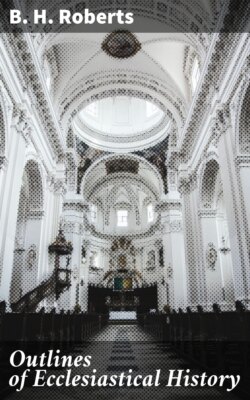Читать книгу Outlines of Ecclesiastical History - B. H. Roberts - Страница 11
На сайте Литреса книга снята с продажи.
Оглавление4. Traditions of Aborigines Respecting Messiah.—It is beyond all question that the descendants of the Nephites and Lamanites—the American Indians—have kept in their traditions a recollection—though perhaps a distorted one—of the memorable visit of Messiah to their forefathers. "The chief divinity of the Nahua nations," says Bancroft in his "Native Races," "was Quetzalcoatl, the gentle God, ruler of the air, controller of the sun and rain, and source of all prosperity. * * * From toward the rising sun Quetzalcoatl, had come; and he was white, with large eyes and long, black hair and copious beard. He finally set out for some other country[83] and as he departed from them his last words were that "one day bearded white men, brethren of his, perhaps he himself, would come by way of the sea in which the sun rises, and would enter in and rule the land;" and from that day, with a fidelity befitting Hebrews waiting for the coming of Messiah, the Mexican people watched for the fulfillment of this prophecy, which promised them a gentle rule, free from bloody sacrifices and oppression."—Roberts.
5. The Incarnation Believed by the Mexicans.—How truly surprisingg is it to find that the Mexicans who seemed to have been unacquainted with the doctrine of the migration of the soul, should have believed in the incarnation of the only Son of the supreme God!—Humboldt.
6. Crucifixion and Atonement Believed in by Mexicans.—Quetzalcoatl is there (in a certain plate where that God is represented) painted in the attitude of a person crucified, with the impression of nails in his hands and feet, but not actually upon the cross. * * * The seventy-third plate of the Borgian Ms. is the most remarkable of all, for there Quetzalcoatl is not only represented as crucified upon a cross of Greek form, but his burial and descent into hell are also depicted in a very curious manner. * * * The Mexicans believe that Quetzalcoatl took human nature upon him, partaking of all the infirmities of man, and was not exempt from sorrow, pain or death, which he suffered voluntarily to atone for the sins of man.—"Antiquities of Mexico"—Kingsborough.
7. Christ and Quetzalcoatl.—The story of the life of the Mexican divinity, Quetzalcoatl, closely resembles that of the Savior; so closely indeed that we can come to no other conclusion than that Quetzalcoatl and Christ are the same being. But the history of the former has been handed down to us through an impure Lamanitish source, which has sadly disfigured and perverted the original incidents and teachings of the Savior's life and ministry.—"Mediation and Atonement"—President John Taylor.
REVIEW.
1. What occurred on the third day of Christ's burial?
2. State the several prophecies made by Jesus which were fulfilled in his resurrection? (note).
3. Relate the account of the resurrection as given by Matthew.
4. In respect to what are there slight discrepancies in the writings of Matthew, Mark, Luke and John?
5. What can you say of the fragmentary character of the New Testament "Gospels?" (Notes 1 and 2).
6. State the most probable order in which Jesus made his several appearances after the resurrection.
7. How long was Jesus with his disciples on the eastern hemisphere after his resurrection?
8. What notable commission did Jesus give to the apostles before leaving them?
9. What signs did Messiah say should follow believers?
10. Describe the last parting of Jesus from his disciples.
11. What prophecy did Jesus make to his disciples at Jerusalem that they did not understand?
12. Give an account of Messiah's visit to the Nephites.
13. What did Jesus do among the Nephites?
14. What was the effect that followed the preaching of the gospel and the organization of the church?
15. What course was pursued as to the quorum of the apostles?
16. Relate the several traditions of the Mexicans respecting the visit of Messiah to this land.
